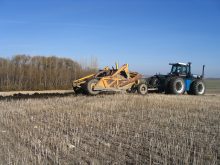A few grams per acre of some micronutrients are enough for most crops, yet they are just as important to plant health as macronutrients like nitrogen and phosphorus.
But many growers are unsure how to apply micronutrients to achieve a yield response, said Jeff Schoenau, professor of soil fertility at the University of Saskatchewan.
He said micronutrient deficiencies are mysterious and difficult to understand.
“They are kind of ghostly because they appear, and then they disappear. The symptoms are often times easily confused with other forms of stress, so we can get a little bit messed up,” Schoenau said during his presentation at the University of Saskatchewan Soils and Crops meeting in Saskatoon.
Read Also

StatCan stands by its model-based crop forecast
Statistics Canada’s model-based production estimates are under scrutiny, but agency says it is confident in the results.
Micronutrient deficiencies often show up only when a unique combination of soil, environmental and crop conditions arise together.
Micronutrient research work is challenging because of variabilities in the soil and the environment, as well as the changing behaviour of the micronutrient in the soil and in the plant.
Many treatment replications are usually needed in studies to detect often very small differences in yields.
“With all of the variability, it makes it hard to come up with statistically significant effects. Because the responses are often small, fleeting and variable,” Schoenau said.
To help demystify when and where applications of specific micronutrients will provide a response, Schoenau went through a list of micronutrients that prairie growers should keep in mind.
“When it comes to the micronutrients of interest for Saskatchewan, copper, zinc, boron, manganese, iron, and chlorine are the ones that we’re concerned about.”
He said other micronutrients are important, such as cobalt and molybdenum, which are important for nitrogen fixation, but they are not a concern for western Canadian growers because deficiency incidences are not common in the region.
The micronutrient metals copper, zinc, manganese and iron may be taken up as chelates or as cations — positively charged ions.
Being take up as cations is more important for manganese, while uptake movement as chelates is especially important for iron and zinc.
“Practically, what is important about chelation is it renders that micronutrient metal soluble. Therefore, it can move in the soil with the water to the roots, therefore keeps them available,” Schoenau said.
Chelates that render micronutrients available are naturally produced in the rhizosphere, the zone around the roots where the microbial biomass is affected by the presence of plant roots.
Some micronutrients can be purchased and applied in the chelated form.
Micronutrient uptake occurs through the roots and in the foliage, which is why micronutrient deficiencies can often be addressed by applying micronutrient fertilizer to the leaves.
Micronutrient metals are involved in electron transport, activation of enzyme and regulation of hormones, and some nutrients also play a role in disease resistance.
“Manganese has been reported to play a role in disease resistance, but probably the one we’re maybe most familiar with is copper. Copper deficiency has been linked to an increased incidence of infection of ergot in cereals because the copper-deficient cereal plants tend to have their florets open longer, which increases the potential for the infection of the florets by ergot,” Schoenau said.
Boron is important for cell division at the growing point, the meristem and in cell wall elongation. Deficiency symptoms for boron are found at the plant’s growing point.
“The meristem and cell wall elongation are important for things like the extension of the pollen tubes, and so it affects reproduction and seed formation,” Schoenau said.
“With boron-deficient canola plants, you could see the pods, but if you crack open the pods there aren’t any canola seeds.”
Chlorine exists in the plant as free chloride ions and is important in charge balancing. As well, chloride seems to play an important role in cereal crop disease resistance, which includes root rot, some leaf diseases and leaf spot.
Some micronutrient deficiencies have specific symptoms, such as when leaves of copper-deficient wheat or canaryseed pinch off and twist like a pig’s tail, and when browning of the heads occurs later on.
Visual inspections alone are risky when trying to identify a micronutrient deficiency because deficiencies of two different micronutrients sometimes look similar. Growers should use multiple approaches when diagnosing nutrient deficiencies.
“I know the micronutrient tests, the availability assessments, have received a fair bit of criticism and debate. Based on my experience with my team working on micronutrients over the past few years, I don’t think they are as bad as they are perceived to be,” Schoenau said.
“I think they are no better or worse than the other tests that are out there, for macronutrients for example.”
Micronutrient availability can vary drastically across a field, so it’s important for growers to identify features conducive to micronutrient deficiencies.
Knolls, sand lenses, and gravel runs tend to be areas where deficiencies often occur.
“Identify those areas in a field, sample them separately. Sampling inside and outside those areas can give you a pretty good indication if, in fact, a micronutrient deficiency exists.
“Also, you might want to address that through a precision micronutrient fertilization,” Schoenau said.
Sandy soils in particular contain low content of minerals capable of releasing micronutrients by weathering.
Growers should consider soil pH an important soil property when looking for micronutrient deficiencies.
“As a generalization, we can say for all micronutrients, the exception is molybdenum, as pH increases, the solubility and therefore the availability of micronutrients tends to go down,” Schoenau said.
“Calcareous soils, high lime content in other words with high pH, they tend to have greater propensity to fix micronutrients, especially micronutrient metals like copper and zinc and iron into soluble forms.”
Soils with very high or very low organic matter can also be a good place to look for micronutrient deficiencies.
“Low organic matter can contribute to boron deficiency, with lower availability. On the other hand, peaty soils don’t contain any minerals and often times can suffer from deficiency in micronutrient metals, copper, zinc and manganese,” Schoenau said.
Nutrient imbalances can also affect micronutrient availability. For example, if there is a large amount of available phosphorus in the soil from fertilization, the phosphorus can tie up and interfere with zinc and copper availability.
“A phosphorus-induced zinc deficiency is something to keep an eye on if you’re putting lots of phosphorus on and you’ve got conditions where the soils are maybe marginal or low in zinc,” Schoenau said.
He said the addition of copper and zinc together appears to have an antagonistic effect and cause reduced crop growth in soils that are very low in available phosphorus. This interaction is not well understood.
It’s difficult to establish clear-cut recommendations for critical levels of micronutrient availability.
“You really can’t draw a definitive line in the sand. We have this grey area where we’re not really sure, but around this level or below there is not a bad chance that we will see a response if all of the other things come together,” Schoenau said.
Growers also need to be aware that they will see a response to micronutrient fertilization one year, but that doesn’t mean they will see a response the following year when conditions are even slightly different.
Micronutrients that may provide yield responses in prairie soils include:
- Copper is the most likely micronutrient to see deficiency issues in Saskatchewan.
- Durum seems to be the most susceptible to a copper deficiency.
- Copper deficiencies have been reported in western Saskatchewan and Alberta, where there is a greater frequency of copper deficiencies.
- Foliar applications of copper have been shown to correct copper deficiencies. Soil applications can be effective as well.
“The one thing about soil application (of copper) especially at higher rates of two, three, five kilograms per hectare, you do have the potential of carryover of that copper into subsequent crops and provide a benefit down the road in the rotation,” Schoenau said.
He worked with Ryan Hangs to conduct research that evaluated copper, zinc, and boron in a wheat-pea-canola rotation.
They observed the crop effects in the year of fertilization and also the residual effects in following years and crops.
The study used 12 different soils that researchers suspected would have a response to micronutrient fertilization.
On average, the copper fertilization, both banded and foliar applied, provided a significant response in the wheat crop.
One treatment, however, caused adverse effects.
“One interesting thing is where we banded chelated copper and we got a negative response. I think probably what we might have been seeing, there is some toxicity.
“So, with micronutrient elements, we always have to remember there is a fine line between deficiency and toxicity,” Schoenau said.
In the second year of the study, peas were grown with an additional zinc fertilization.
In areas that received a zinc application but did not receive a copper application the previous year, there was a slight trend toward higher yields but the increase wasn’t statistically significant.
“But what’s interesting here and kind of surprising to us, is we actually saw a statistically significant response of the pea yield to copper that had been applied the year before to the wheat,” Schoenau said.
He said he’s not sure why peas responded to soil-applied copper the year before, but it may be due to a fungicidal effect of the copper.
Some soils in the study were very phosphorus deficient, and a negative effect on pea yield was observed when zinc and copper were added together.
However, he said this adverse effect from zinc and copper applied at the same time likely wouldn’t be seen in the field.
“You probably wouldn’t encounter too many instances where a grower put on zinc and copper but didn’t apply phosphorus fertilizer,” Schoenau said.
Good responses have been observed from zinc sulfate addition in dryland cereals, but few statistically significant yield responses from zinc fertilization have been observed in pulses.
The zinc content in harvested grain is important from a marketability standpoint for pulse crops.
There is a fairly high zinc deficiency in the population of countries like Bangladesh and Pakistan, where some prairie pulse crops end up.
Fertilization of zinc has been shown to produce a small but significant increase in the concentration of zinc in the harvested pulses.
Canola and alfalfa are potentially susceptible to boron deficiencies.
“I would say that large yield responses to boron fertilization in Western Canada reported out there is really quite rare. Indeed, some studies even on soils that had low extractable boron content, no significant yield response of canola to boron application was observed in the field,” Schoenau said.
In previous research, compared to the control and averaged across the 12 soils, “we didn’t see any response to boron. But when parceled out and looked at the individual soils, we did see a significant response. Those were sandy, low-organic-matter soils, low in available boron,” Schoenau said.
On the organic soils in the study, a response to boron alone was not observed. But a significant yield response to boron application was observed where there was a zinc application to peas the previous year.
Peaty soils with little mineral sources may be responsive to a manganese application in cereals.
“Deficiencies of manganese are certainly not a problem in mineral soils in Saskatchewan by in large. But manganese toxicity has been suspected and confirmed in sandy acidic grey soils in east-central Saskatchewan,” Schoenau said.
Manganese toxicity produce a kind of necrosis on leaf edges and it looks similar to sulphur deficiency. With manganese toxicity, the leaves get a little bit of bubbling and they curl.
Schoenau participated in an experiment where lime was added at a rate of about 0.8 tonnes per acre, which changed the pH from 5.5 to 6.1, on soils that caused manganese toxicity in canola.
The liming of the soils nearly doubled the early season dry-matter yield of the canola and significantly decreased the manganese concentration in the plant tissue.
Soybean growers must pay close attention to iron because of iron deficiency chlorosis (IDC).
Yellow leaves with green leaf veins in the newest leaves caused by IDC often appear as soybean enters the first to third trifoliate leaf stage.
“It’s kind of a unique combination of conditions that leads to IDC. High pH, poor drainage where the soil is a little bit saturated, high nitrate content, carbonate salts are all the kinds of conditions that aggravate iron deficiency,” Schoenau said.
He said the issue has largely been addressed through genetics because some soybeans varieties are not prone to IDC.
The IDC sensitivity ratings for soybeans are listed in the guide book.
“Genetics is probably the best defence, but foliar iron may be a suitable rescue treatment. It also does seem that soybeans can sometimes grow out of the IDC condition on their own,” Schoenau said.
There is a potential for response to chloride fertilization in cereals, especially canaryseed, in highly leached soils with low extractable chloride. This response may be associated with disease pressure.
“More widespread use of potash application has probably reduced incidents of chloride limitation. One of the reason is nearly all of the chloride stays behind in the field, in the straw,” Schoenau said.


















